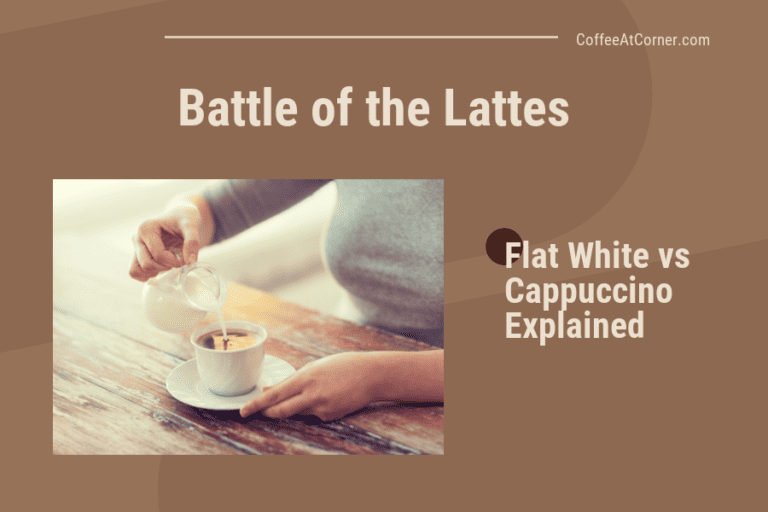Cortado vs Cappuccino: Understanding the Differences Between Two Classic Espresso Drinks

Cortado and cappuccino are two popular coffee drinks that many people often confuse. While they may appear similar at first glance, they are actually quite different in terms of taste, texture, and preparation. In this article, we will take a closer look at what sets the cortado and cappuccino apart, and help you decide which one is best for you.
Understanding Cortado: A cortado is a Spanish coffee drink that consists of equal parts espresso and steamed milk. It is typically served in a small glass and has a smooth, velvety texture. The cortado is known for its rich, bold flavor and is often enjoyed as a mid-morning or mid-afternoon pick-me-up.
Understanding Cappuccino: A cappuccino, on the other hand, is an Italian coffee drink that is made with espresso, steamed milk, and frothed milk. It is typically served in a larger cup and has a thick, creamy texture. The cappuccino is known for its sweet, nutty flavor and is often enjoyed as a breakfast drink.
Comparing Cortado and Cappuccino: While both the cortado and cappuccino are espresso-based drinks, they differ in terms of milk-to-espresso ratio, texture, and taste. The cortado has a higher ratio of espresso to milk, resulting in a stronger coffee flavor and less creamy texture. The cappuccino, on the other hand, has a higher ratio of milk to espresso, resulting in a sweeter flavor and creamier texture. Ultimately, the choice between a cortado and cappuccino comes down to personal preference.
Understanding Cortado
Origin and History of Cortado
Cortado is a popular espresso drink that originated in Spain. The word “cortado” comes from the Spanish verb “cortar,” which means “to cut.” The drink was named cortado because it is made by “cutting” the espresso with warm milk. The drink is also known as “Gibraltar” in the US, named after the glass it is served in.
Characteristics of Cortado
Cortado is a double shot of espresso with an equal amount of warm milk. The milk is steamed and then poured into the espresso, creating a velvety texture and a smooth, rich flavor. The milk ratio is lower than other espresso drinks, resulting in a stronger coffee taste. Cortado is less creamy than cappuccino, making it a great option for those who prefer a stronger coffee flavor.
The Role of Espresso in Cortado
Espresso is the base of cortado. It is made by forcing hot water through finely ground espresso beans, resulting in a concentrated shot of coffee. The double shot of espresso in cortado provides a strong coffee flavor that is balanced by the warm milk.
Milk Texture in Cortado
The milk in cortado is steamed to create a velvety texture. The steamed milk is then poured into the espresso, creating a smooth and creamy drink. The milk is not frothed like in cappuccino, resulting in a thinner layer of foam.
Cortado Size and Preparation
Cortado is typically served in a small glass or ceramic cup. The size of the drink is smaller than a latte or cappuccino, usually around 4-5 ounces. Cortado is prepared by pulling a double shot of espresso and then adding an equal amount of steamed milk.
In conclusion, cortado is a delicious espresso drink that is perfect for those who prefer a stronger coffee taste. Its origins can be traced back to Spain, where it is still a popular drink today. The drink is made by cutting the espresso with warm milk, resulting in a smooth and velvety texture. The milk ratio is lower than other espresso drinks, resulting in a stronger coffee taste. Cortado is typically served in a small glass or ceramic cup and is prepared by pulling a double shot of espresso and adding an equal amount of steamed milk.
Understanding Cappuccino
Origin and History of Cappuccino
Cappuccino is an espresso drink that originated in Italy. The drink is named after the Capuchin friars because the color of the espresso mixed with frothed milk resembled the color of the friars’ robes. Cappuccino is believed to have been invented in the early 1900s, and it quickly became popular in Italy. In the 1930s, cappuccino was introduced to the United States, where it gained popularity as a breakfast drink.
Characteristics of Cappuccino
Cappuccino is made with espresso and frothed milk. The drink is typically served in a small cup and has a creamy texture. The ratio of milk to espresso in a cappuccino is about 1:1, and the milk is frothed to create a layer of foam on top of the drink. The foam is an important part of the cappuccino, as it helps to balance the bitterness of the espresso and creates a smooth, creamy texture.
The Role of Espresso in Cappuccino
Espresso is the foundation of a cappuccino. It is made by forcing hot water through finely ground espresso beans, producing a concentrated shot of coffee. The espresso in a cappuccino provides the drink with its bold, rich flavor and caffeine content. Typically, a cappuccino is made with one or two shots of espresso, depending on the size of the drink.
Milk and Foam in Cappuccino
Milk is an essential ingredient in a cappuccino. It is steamed and frothed to create a layer of foam on top of the drink. The milk used in a cappuccino is typically whole milk, but some coffee shops offer alternative milk options such as almond milk or oat milk. The ratio of milk to foam in a cappuccino is about 1:1, and the foam is created by introducing air into the milk as it is steamed.
Cappuccino Size and Preparation
Cappuccino is typically served in a small cup, usually around 6 ounces. The drink is prepared by pulling one or two shots of espresso and then adding steamed milk and foam. The milk and foam are added in equal parts, creating a creamy texture and a layer of foam on top of the drink. Some coffee shops offer variations of the cappuccino, such as a dry cappuccino with less milk foam or a wet cappuccino with more steamed milk.
Overall, cappuccino is a popular espresso drink that is known for its creamy texture and bold flavor. It is a classic Italian drink that has gained popularity around the world. While similar to other espresso drinks like latte or macchiato, cappuccino has its own unique characteristics, such as the equal milk to foam ratio and the small cup size.
Comparing Cortado and Cappuccino
When it comes to espresso drinks, two of the most popular options are cortado and cappuccino. While they may seem similar, there are some significant differences between them. In this section, we will compare cortado and cappuccino across various aspects to help you understand the differences better.
Texture Comparison
One of the biggest differences between cortado and cappuccino is their texture. Cortado is a smoother drink with a velvety texture due to the equal parts of espresso and steamed milk. In contrast, cappuccino has a more textured and frothy texture due to the addition of foamed milk on top.
Taste and Flavor Comparison
Cortado and cappuccino have different taste and flavor profiles. Cortado has a bolder espresso flavor with a slight sweetness from the steamed milk. On the other hand, cappuccino has a more balanced flavor due to the addition of foamed milk, which adds sweetness and a creamy texture to the drink.
Ingredients and Preparation Comparison
Both cortado and cappuccino are espresso-based drinks, but the ingredients and preparation methods differ. Cortado is made with equal parts espresso and steamed milk, while cappuccino consists of one-third espresso, one-third steamed milk, and one-third foamed milk. The preparation method for both drinks is similar, with the espresso shot pulled first, followed by the addition of steamed milk and foamed milk.
Size and Ratio Comparison
Cortado and cappuccino also differ in terms of their size and ratio. Cortado is a smaller drink, typically served in a smaller cup with a double shot of espresso and an equal amount of steamed milk. In contrast, cappuccino is a larger drink with a double shot of espresso and a larger amount of steamed milk and foamed milk, typically served in a larger cup.
Calorie and Nutrient Comparison
Cortado and cappuccino have similar calorie counts, with cortado containing around 70-80 calories and cappuccino containing around 120-140 calories. Both drinks contain similar nutrients, such as protein, calcium, and vitamin D, but the nutrient content may vary depending on the type of milk used.
Cost and Availability Comparison
The cost and availability of cortado and cappuccino vary depending on the coffee shop and location. Generally, cappuccino is more widely available and may cost slightly more than cortado due to the additional ingredients and preparation time required.
In summary, cortado and cappuccino have some similarities, but the biggest difference between them is the texture, taste, and ratio of ingredients. Ultimately, the choice between cortado and cappuccino comes down to personal preference and the desired coffee experience.

Conclusion
In conclusion, both cortado and cappuccino are popular coffee drinks that are enjoyed by many coffee lovers. While they share some similarities, such as the use of espresso and steamed milk, they have distinct differences in terms of taste, texture, and preparation.
Cortado is a type of coffee that originated in Spain and has gained popularity around the world. It is made by combining equal parts of espresso and steamed milk, resulting in a smooth and balanced flavor. Cortado is typically served in smaller glasses and does not have any foam on top.
On the other hand, cappuccino is a classic Italian coffee drink that is made by combining equal parts of espresso, steamed milk, and frothed milk. It has a stronger espresso taste and a layer of thick foam on top. Cappuccinos are typically served in larger glasses and can be enjoyed hot or cold.
When it comes to choosing between cortado and cappuccino, it ultimately comes down to personal preference. If you prefer a smoother and more balanced flavor, then cortado may be the right choice for you. However, if you prefer a stronger espresso taste and a layer of foam on top, then cappuccino may be the way to go.
Overall, both cortado and cappuccino are delicious coffee drinks that can be enjoyed at any time of the day. Whether you’re a coffee aficionado or just looking for a tasty pick-me-up, these drinks are sure to satisfy your caffeine cravings.
Frequently Asked Questions
What is the difference between a cortado and a cappuccino?
A cortado is a small coffee drink made with equal parts espresso and steamed milk. A cappuccino, on the other hand, is a larger drink made from ⅓ espresso, ⅓ steamed milk, and ⅓ foam. While both drinks contain espresso and milk, the proportions and texture of the drinks are different.
Which coffee has more milk: cortado or cappuccino?
A cappuccino has more milk than a cortado. A cortado is made with equal parts espresso and steamed milk, while a cappuccino is made with ⅓ espresso, ⅓ steamed milk, and ⅓ foam.
How does a cortado compare to a macchiato and a cappuccino?
A cortado is similar to a macchiato in that both drinks are made with espresso and milk. However, a cortado has more milk than a macchiato, and the milk is steamed rather than frothed. A cappuccino contains more foam than a cortado and has a different texture.
Is a cortado stronger than a cappuccino?
A cortado and a cappuccino both contain the same amount of espresso, so they have the same amount of caffeine. However, a cortado may taste stronger because it has less milk and foam than a cappuccino.
What is the difference between a cortado and a cortadito?
A cortado and a cortadito are similar drinks, but a cortadito is a Cuban version of a cortado. A cortadito is made with a shot of espresso and steamed milk, but it also contains a small amount of sugar. A cortado does not contain sugar.
Is a cortado similar to a flat white?
A cortado and a flat white are similar in that they both contain espresso and steamed milk. However, a flat white is made with more milk than a cortado, and it also contains microfoam. A cortado has a different texture and is served in a smaller cup.






One Comment